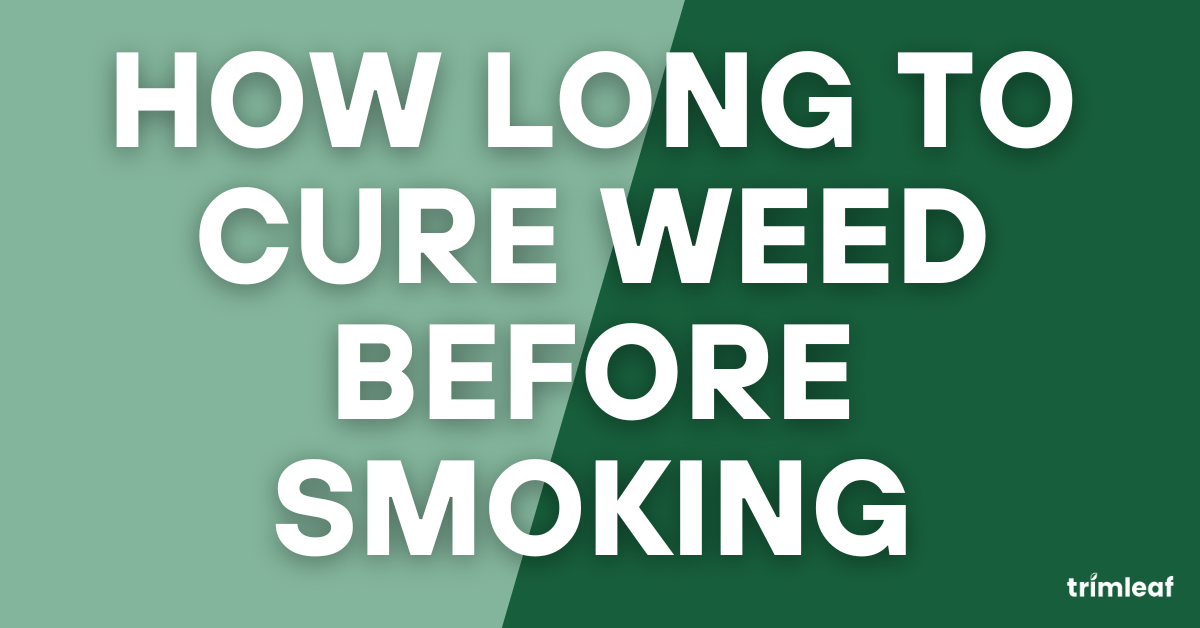
When your cannabis is finally harvested, it might feel like the hard part is over. But if you’re aiming for smooth, flavorful, and potent bud, there’s one more crucial step: curing. Even if your buds are dry on the surface, rushing to smoke them without a proper cure process can sabotage months of work.
In this guide, you'll learn exactly how long to cure weed before smoking, what happens during curing, how to do it right, and why this step can make or break your final product. Whether you grow cannabis at home or manage larger operations, this resource will walk you through everything you need to know to cure cannabis and elevate your harvest properly.
Table of Contents
Why You Should Cure Cannabis (and Not Just Dry It)
Most beginners are eager to skip straight from the drying process to consumption. But the truth is: drying and curing are two entirely different stages, both critical for quality.

The Role of Drying
After harvest, the drying process reduces surface moisture from the outer layers of the cannabis buds. But even when the buds feel dry, they still retain internal moisture that can lead to mold, harsh smoke, and reduced potency if not addressed through curing.
What Curing Does
The curing weed breaks down sugars and chlorophyll that remain after the drying time. This results in enhanced taste, more stable and potent THC and CBD levels.
If skipped or rushed, freshly harvested cannabis often tastes bitter, burns unevenly, and has diminished potency. The curing process ensures optimal cannabinoid and terpene preservation.
Curing Essentials to Get Started
A successful cure comes down to consistency, both in environment and handling. Having the right tools on hand makes it much easier to maintain those conditions.
- Glass jars for airtight storage that preserves aroma and potency.
- Humidity control packs (58–62% RH) to maintain the ideal curing range without constant checks.
- Curing lids that help regulate airflow and reduce the need for frequent burping.
- Jar Hygrometers
- Small Dehumidifiers
Some cultivators also use freeze dryers, which can deliver a properly cured product in a fraction of the time while still preserving potency and terpenes. And if you want to refine your process further, checking out a complete guide to drying curing cannabis to help you fine-tune humidity levels, airflow, and timing for the best results.
How Long Does It Take to Cure Weed Before Smoking?
So, how long should you actually cure cannabis? It depends on your quality goals and environment.
| Duration | Result |
|---|---|
| 1–2 weeks | Minimally improved flavor, harshness reduced slightly |
| 3–4 weeks | Noticeable terpene development, smoother smoking |
| 6–8 weeks | Full flavor, max potency, best smoothness |
| 4+ months | Connoisseur-level aging, very complex aroma |
In general, curing cannabis can take anywhere from two weeks to several months. Properly curing and drying cannabis isn’t about speed—it’s about control and quality. Some cultivators prefer to cure for 4–6 months for rare strains or competitive-grade harvests.
What Affects the Curing Time?
While 3–8 weeks is a good general window, the exact time it takes to cure cannabis can vary greatly depending on several factors. Understanding these variables helps you gauge your own timeline more accurately:
Bud size and density
Larger or denser buds take longer to dry evenly and cure properly. Smaller buds may be ready to smoke sooner, but they still benefit from time in the jar.
Humidity control
If your curing jars stay within the ideal RH range (58–62%), the process will move along smoothly. Too much moisture slows things down or risks mold.
Initial dryness
If buds go into the jar while still too wet, the curing timeline resets and must be extended. Conversely, if they’re too dry, terpene degradation accelerates.
Jar opening habits
Frequent burping in the first 1–2 weeks helps maintain airflow and control moisture levels. Inconsistent monitoring can slow or stall the cure.
Each batch is different. Some cultivators find that certain strains require a longer curing phase to unlock full terpene expression, while others plateau around week 4.
Signs You’re Curing Weed Correctly

If you’re unsure whether your cure process is on track, keep an eye (and nose) out for these signs of progress:
- The “green” or grassy smell fades within the first 1–2 weeks. As time goes on, pungent, sweet, earthy, or fuel-like aromas emerge.
- Buds should feel slightly spongy but not wet, and break apart without crumbling.
- If the cannabis makes you cough less and burns evenly, you’re approaching a good cure.
- Well-cured buds retain their frosty trichome coverage with minimal degradation.
- Overly brittle buds may indicate overdrying.
Remember, the best way to evaluate your cure is by sampling small amounts over time. You’ll notice when your cannabis is ready by how it smokes and smells.
Should You Always Cure Weed?
While many home growers wonder if curing is optional, the short answer is: yes, always cure, if you care about quality. Even with top-tier genetics or growing methods, skipping this step undermines everything that makes great cannabis truly exceptional.
Curing unlocks the full potential of your cannabis. From better flavor to longer storage, here’s why curing deserves your attention.
Why You Should Cure Weed
- 🟢 Enhances flavor and smoothness
- 🟢 Improves potency and aroma
- 🟢 Preserves cannabinoids and terpenes
- 🟢 Extends shelf life
When You Can’t Skip It
- 🟠 You’re growing for personal use
- 🟠 You’re storing buds long-term
- 🟠 You’re making extracts or rosin
- 🟠 You want maximum terpene preservation
Final Thoughts
The time it takes to properly cure cannabis might test your patience—but the results speak for themselves. From flavor to potency, the cure process elevates your cannabis flower from decent to exceptional.
Dry and cure marijuana the right way using sealed jars, regular burping, and time. Whether you’re prepping a small home batch or managing commercial-grade bud, curing cannabis properly is a must for any grower who cares about quality.
Frequently Asked Questions About Curing Weed Before Smoking
- ◄Can I smoke cannabis right after drying?
-
Technically yes, but you’ll lose flavor, smoothness, and possibly even potency. Drying and curing cannabis unlocks its full potential.
- ◄Can I speed up the curing process?
-
While it’s tempting, rushing will lead to harsh hits and degraded terpenes. A 2-week cure is the minimum—but weeks of curing deliver better outcomes.
- ◄How do I know the cannabis is dry and ready?
-
Snap small stems and check that buds aren’t wet. Buds should feel dry outside but slightly springy inside. Larger buds may take longer to dry.
- ◄How long does it take to properly cure cannabis?
-
Most growers cure for 3–4 weeks for smoother smoke, but 6–8 weeks yields superior flavor and potency. High-end cultivators may cure for several months.
- ◄Can I use plastic bags or Tupperware instead of mason jars for curing?
-
Plastic isn’t ideal. Use glass mason jars—they’re airtight, don’t leach chemicals, and won’t generate static that can damage trichomes.
- ◄What happens if I don’t cure my weed?
-
Uncured buds taste harsh, smell grassy, and may lose potency. Skipping curing increases throat irritation and reduces the psychoactive experience.
- ◄Should I trim before or after drying cannabis?
-
Wet trimming is faster and can reduce drying time. Dry trimming preserves terpenes and slows drying slightly. Choose based on your environment and goals.
- ◄What’s the best humidity level when curing cannabis?
-
Keep RH between 58–62% inside jars. Use a hygrometer to monitor. Too dry = brittle buds. Too humid = mold risk.
- ◄Can I cure cannabis without burping the jars?
-
No. Burping prevents mold and ensures even curing. It’s essential for the first 2–3 weeks until RH stabilizes inside the jar.
- ◄How do I store cured cannabis for long-term freshness?
-
Use airtight glass jars in a dark, cool space. Avoid opening unnecessarily. Stable RH and temperature will keep buds fresh for 12 months or more.




